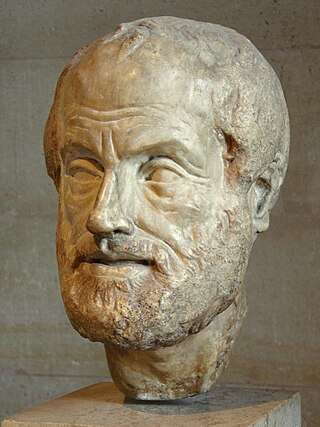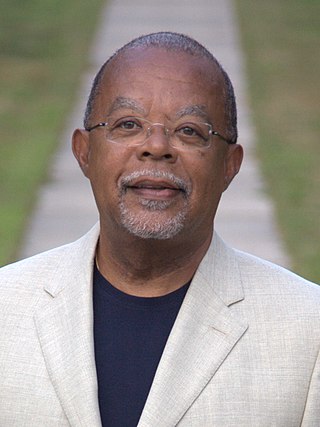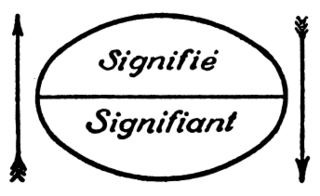Related Research Articles
In philosophy, deconstruction is a loosely-defined set of approaches to understanding the relationship between text and meaning. The concept of deconstruction was introduced by the philosopher Jacques Derrida, who described it as a turn away from Platonism's ideas of "true" forms and essences which are valued above appearances.

Ferdinand de Saussure was a Swiss linguist, semiotician and philosopher. His ideas laid a foundation for many significant developments in both linguistics and semiotics in the 20th century. He is widely considered one of the founders of 20th-century linguistics and one of two major founders of semiotics, or semiology, as Saussure called it.
Post-structuralism is a philosophical movement that questions the objectivity or stability of the various interpretive structures that are posited by structuralism and considers them to be constituted by broader systems of power. Although post-structuralists all present different critiques of structuralism, common themes among them include the rejection of the self-sufficiency of structuralism, as well as an interrogation of the binary oppositions that constitute its structures. Accordingly, post-structuralism discards the idea of interpreting media within pre-established, socially constructed structures.

Structuralism is an intellectual current and methodological approach, primarily in the social sciences, that interprets elements of human culture by way of their relationship to a broader system. It works to uncover the structural patterns that underlie all the things that humans do, think, perceive, and feel.

Literary theory is the systematic study of the nature of literature and of the methods for literary analysis. Since the 19th century, literary scholarship includes literary theory and considerations of intellectual history, moral philosophy, social philosophy, and interdisciplinary themes relevant to how people interpret meaning. In the humanities in modern academia, the latter style of literary scholarship is an offshoot of post-structuralism. Consequently, the word theory became an umbrella term for scholarly approaches to reading texts, some of which are informed by strands of semiotics, cultural studies, philosophy of language, and continental philosophy, often witnessed within Western canon along with some postmodernist theory.
"Logocentrism" is a term coined by the German philosopher Ludwig Klages in the early 1900s. It refers to the tradition of Western science and philosophy that regards words and language as a fundamental expression of an external reality. It holds the logos as epistemologically superior and that there is an original, irreducible object which the logos represent. According to logocentrism, the logos is the ideal representation of the Platonic ideal.

Course in General Linguistics is a book compiled by Charles Bally and Albert Sechehaye from notes on lectures given by historical-comparative linguist Ferdinand de Saussure at the University of Geneva between 1906 and 1911. It was published in 1916, after Saussure's death, and is generally regarded as the starting point of structural linguistics, an approach to linguistics that was established in the first half of the 20th century by the Prague linguistic circle. One of Saussure's translators, Roy Harris, summarized Saussure's contribution to linguistics and the study of language in the following way:
Language is no longer regarded as peripheral to our grasp of the world we live in, but as central to it. Words are not mere vocal labels or communicational adjuncts superimposed upon an already given order of things. They are collective products of social interaction, essential instruments through which human beings constitute and articulate their world. This typically twentieth-century view of language has profoundly influenced developments throughout the whole range of human sciences. It is particularly marked in linguistics, philosophy, psychology, sociology and anthropology.
African American literature is the body of literature produced in the United States by writers of African descent. Olaudah Equiano was an African man who wrote The Interesting Narrative of the Life of Olaudah Equiano, an autobiography published in 1789 that became one of the first influential works about the transatlantic slave trade and the experiences of enslaved Africans. His work was published sixteen years after Phillis Wheatley's work. She was an enslaved African woman who became the first African American to publish a book of poetry, which was published in 1773. Her collection, was titled Poems on Various Subjects, Religious and Moral.
Signifyin' (sometimes written "signifyin(g)") is a practice in African-American culture involving a verbal strategy of indirection that exploits the gap between the denotative and figurative meanings of words. A simple example would be insulting someone to show them affection. Other names for signifyin' include: "Dropping lugs, joaning, sounding, capping, snapping, dissing, busting, bagging, janking, ranking, toasting, woofing, roasting, putting on, or cracking."

Mumbo Jumbo is a 1972 novel by African-American author Ishmael Reed, originally published by Doubleday in New York. The novel has remained continuously in print in the decades since its first edition. It was first published in the UK by Allison and Busby, and has been published in translation in several languages, including French, Italian, Spanish, Japanese, as well as a Chinese translation in 2019. The novel was released as a Penguin Modern Classic in 2017.

Representation is the use of signs that stand in for and take the place of something else. It is through representation that people organize the world and reality through the act of naming its elements. Signs are arranged in order to form semantic constructions and express relations.
Barbara Ellen Johnson was an American literary critic and translator, born in Boston. She was a Professor of English and Comparative Literature and the Fredric Wertham Professor of Law and Psychiatry in Society at Harvard University. Her scholarship incorporated a variety of structuralist and poststructuralist perspectives—including deconstruction, Lacanian psychoanalysis, and feminist theory—into a critical, interdisciplinary study of literature. As a scholar, teacher, and translator, Johnson helped make the theories of French philosopher Jacques Derrida accessible to English-speaking audiences in the United States at a time when they had just begun to gain recognition in France. Accordingly, she is often associated with the "Yale School" of academic literary criticism.
Houston Alfred Baker Jr. is an American scholar specializing in African-American literature and Distinguished University Professor of English at Vanderbilt University. Baker served as president of the Modern Language Association, editor of the journal American Literature, and has authored several books, including The Journey Back: Issues in Black Literature and Criticism, Modernism and the Harlem Renaissance (1987), Blues, Ideology, and Afro-American Literature (1984), and Workings of the Spirit: The Poetics of Afro-American Women's Writing (1993), as well as editing literary collections. Baker was included in the 2006 textbook Fifty Key Literary Theorists, by Richard J. Lane.

Barbara T. Christian was an American author and professor of African-American Studies at the University of California, Berkeley. Among several books, and more than 100 published articles, Christian was best known for the 1980 study Black Women Novelists: The Development of a Tradition.
Diaspora literacy is a phrase coined by literary scholar Vévé Clark in her work "Developing Diaspora Literacy and Marasa Consciousness". It is the ability to understand and/or interpret the multi-layered meanings of stories, words, and other folk sayings within any given community of the African diaspora. These meanings supersede those of "...Western or westernized signification" (42), meaning that they go beyond literal or typical literary interpretation into an area of folk understanding that could only be recognized by the eye skilled in such an understanding. Readers rely solely upon a knowledge and lived experience of social, historical, and cultural climates of the various cultures of the African diaspora as a foundation for interpretation.
Structural linguistics, or structuralism, in linguistics, denotes schools or theories in which language is conceived as a self-contained, self-regulating semiotic system whose elements are defined by their relationship to other elements within the system. It is derived from the work of Swiss linguist Ferdinand de Saussure and is part of the overall approach of structuralism. Saussure's Course in General Linguistics, published posthumously in 1916, stressed examining language as a dynamic system of interconnected units. Saussure is also known for introducing several basic dimensions of semiotic analysis that are still important today. Two of these are his key methods of syntagmatic and paradigmatic analysis, which define units syntactically and lexically, respectively, according to their contrast with the other units in the system. Other key features of structuralism are the focus on systematic phenomena, the primacy of an idealized form over actual speech data, the priority of linguistic form over meaning, the marginalization of written language, and the connection of linguistic structure to broader social, behavioral, or cognitive phenomena.
The signifying monkey is a character of African-American folklore that derives from the trickster figure of Yoruba mythology, Esu Elegbara. This character was transported with Africans to the Americas under the names of Exu, Echu-Elegua, Papa Legba, and Papa Le Bas. Esu and his variants all serve as messengers who mediated between the gods and men by means of tricks. The signifying monkey is "distinctly Afro-American" but is thought to derive from Yoruban mythology, which depicts Echu-Elegua with a monkey at his side.

Signifying Rappers: Rap and Race in the Urban Present is a nonfiction book by Mark Costello and David Foster Wallace. The book explores the music genre's history as it intersected with historical events, either locally and unique to Boston, or in larger cultural or historical contexts.

Henry Louis Gates Jr. is an American literary critic, professor, historian, and filmmaker who serves as the Alphonse Fletcher University Professor and the director of the Hutchins Center for African and African American Research at Harvard University. He is a trustee of the Gilder Lehrman Institute of American History. He rediscovered the earliest known African-American novels and has published extensively on the recognition of African-American literature as part of the Western canon.

In semiotics, signified and signifier are the two main components of a sign, where signified is what the sign represents or refers to, known as the "plane of content", and signifier which is the "plane of expression" or the observable aspects of the sign itself. The idea was first proposed in the work of Swiss linguist Ferdinand de Saussure, one of the two founders of semiotics.
References
- ↑ Gates, Henry Louis. African American Literary Criticism, 1773 to 2000, ed. Hazel Arnett Ervin. New York: Twayne Publishers, 1999. 261.
- ↑ Bell, Bernard W. The Afro-American Novel and Its Traditions. Amherst: University of Massachusetts Press, 1987. 22.
- ↑ Abrahams, Roger D. African American Literary Criticism, 1773 to 2000, ed. Hazel Arnett Ervin. New York: Twayne Publishers, 1999. 260.
- ↑ Saussure, Ferdinand de. "Course in General Linguistics", Structuralism, Linguistics, Narratology. eds. Julie Rivkin and Michael Ryan. 66.
- ↑ Gates, Henry Louis. "The Blackness of Blackness: A Critique on the Sign and the Signifying Monkey", Literary Theory: An Anthology. Eds. Julie Rivkin & Michael Ryan. 992.
- ↑ Baker, Houston A. Blues, Ideology, and Afro-American Literature: A Vernacular Theory. Chicago: University of Chicago Press, 1984. 111.
- ↑ Delbanco, Andrew. "Talking Texts", Black Literature Criticism Supplement, eds. Jeffrey W. Hunter and Jerry Moore. Detroit: Gale, 1999. 142.
- 1 2 Lubiano, Wahneema. "Henry Louis Gates, Jr. and African-American Literary Discourse", Black Literature Criticism Supplement, eds. Jeffrey W. Hunter and Jerry Moore. Detroit: Gale, 1999. 147.
- ↑ Myers, D. G. "Signifying Nothing", New Criterion 8 (1990): 63.
- ↑ Mason, Theodore O. "African American Theory and Criticism: 2. 1977 to 1990". Johns Hopkins Guide To Literary Theory and Criticism. (2005): 2. Johns Hopkins Guide To Literary Theory and Criticism. University of Chicago Library, Chicago, IL. October 11, 2007.